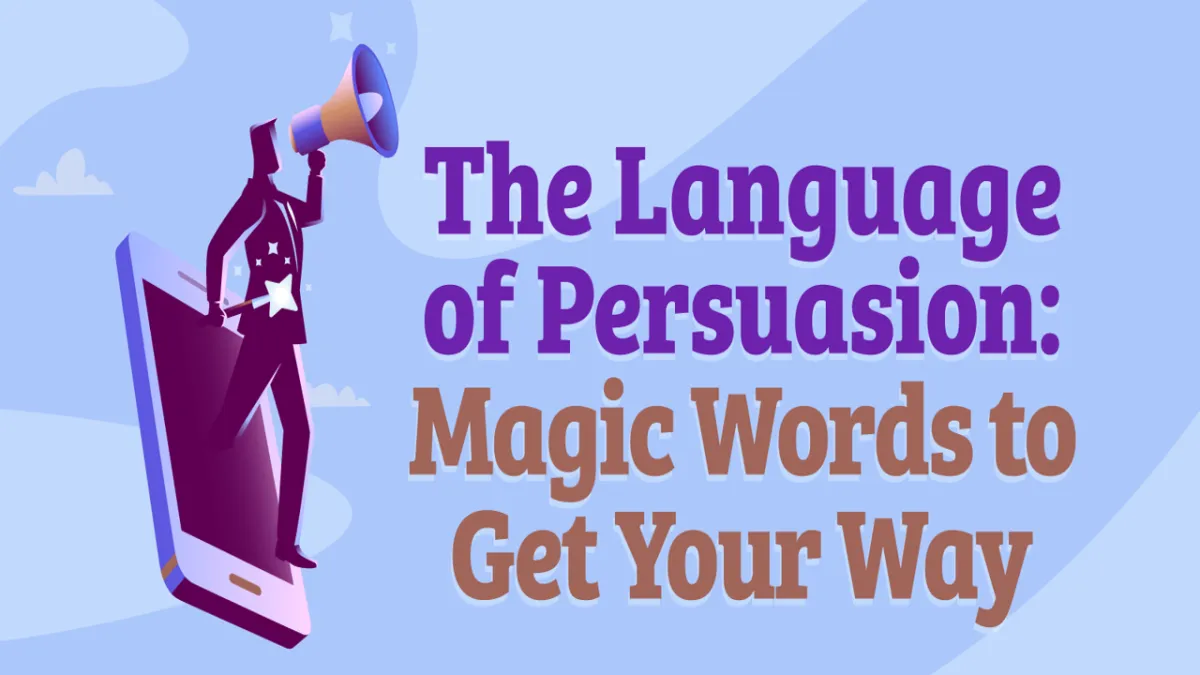Our Blogs
Feel free to browse around and check out one of the very best collections of informative and helpful writings on digital marketing, social media, advertising, lead generation, content creation, and more. Stay up-to-date on the very latest trends impacting our fast-changing world so you can continue to make a Higher Impact in your business, your community, and your world!

The Language of Persuasion: Magic Words to Get Your Way
Introduction:
Want to be more persuasive? Wondering which words will influence people to take action?
In this article, you’ll discover how to use language to guide people to a desired outcome.

👉 How to Make More Impact With Language 👈
Subtle changes of just a few letters can transform the effect our words have. The right language can influence other people, get their attention, make meaningful connections, and persuade them toward a sale or another desired action.
How does that work?
It’s because language shapes how we see ourselves and other people. The right words can persuade your audience that you’re trustworthy, helpful, creative, and knowledgeable. The wrong words can convince them that you’re dishonest, unhelpful, boring, and out of your depth.
Those perceptions can have a major impact on your business. Make the right impression and people will share your content, take your advice, or buy your products. Make the wrong impression and you’ll soon struggle to get any attention at all.
⁉️ But What About AI? ⁉️
If you’ve spent any time online in the past 12 months, then you know that AI is big news. Researchers have developed Natural Language Processing (NLP) models that can read, summarize, imitate, and produce text that sounds convincingly human.
So where does that leave marketers, creators, and content writers? Are we out of a job?
Not just yet. AI is a valuable tool for language but it won’t replace anyone. Remember, even subtle changes in your words can change the effect you have. And AI language programs aren’t up to that level of subtlety yet.
However, they’re useful for helping us analyze and understand language. The tips in this article are based on research that used machine learning and NLP. By analyzing millions of pieces of content—such as customer service calls, slide decks, and blog posts—linguists have started to identify the word hacks that convince, connect, and persuade.
📲 How to Speak and Write More Persuasively 💻
We’re focusing on language in the SPEACC framework, developed by Jonah Berger to understand how to speak more persuasively:
Similarity
Pose questions
Agency and identity
Concreteness
Confidence
The most important elements for your marketing strategy are the final three: agency and identity, concreteness, and confidence.
Each element is connected with different linguistic hacks and applications. When you master them all, you’ll have mastered the art of persuasion.
#1: Agency and Identity
Before we get into the specifics, let’s have some quick definitions:
Agency means being responsible for an action. Who’s in control of a situation? Do they feel proud of their actions?
Identity is about how we perceive ourselves and others. Who do we think we are? How does that affect our behavior?
Language that speaks to agency and identity can make us feel more, or less, in control. It can help us identify as the right person for a product… or the wrong person.
We can even change others’ behavior by linking certain actions, values, or products to more or less desirable identities.
Verbs Versus Names
According to conventional wisdom, marketing content should contain lots of action verbs. Buy! Try! Discover! Join! Experience!
But the science says something different.
A study from Stanford University found that you could activate up to a third more people by asking them “to be a helper,” instead of just asking people “to help.” A similar study found that voter turnout increased by 15% when people were encouraged “to be a voter” instead of just “to vote.”
In other words, when you speak to people’s identities instead of their actions, you get a more active response.
You can use this insight in several different ways:
Motivate your audience by offering them an identity instead of suggesting an action. Think of the success YouTube has had by framing people who post content on the platform as “creators.”
Represent your business or personal brand as an identity. Don’t say “I coach entrepreneurs,” say “I am a coach”!
Downgrade undesirable actions by associating them with unpopular identities. Nobody wants to be a cheater, a loser, or someone who misses out.
Shoulda, Woulda, Coulda
Here’s a behind-the-scenes change that can transform how you plan, market, and grow your business: replace “should” with “could.”
So instead of asking yourself “what should I do?”, ask “what could I do?”
This shifts the agency in your business back to you. Instead of worrying about what other people expect—what you “should” do—you’re making decisions on what’s possible for you, with your unique skills and circumstances.
This also has the bonus side effect of encouraging creativity. Once you get away from “should,” you’re free to come up with new and exciting ideas!
Second and Third Person
You can persuade and dissuade people, empower and disempower them, based on the language you use.
Sometimes, it’s as basic as which person you use: first (“I”), second (“you”), or third (he, she, or they).
On social media, second person (you) is most effective. It grabs people’s attention by putting them in the spotlight. They feel that they have all of the agency. They feel that their identity is recognized.
In customer service, third person (he/she/they) or passive voice is more effective. That’s because when someone has a problem with your product, they don’t want to feel like it’s their fault. They don’t want that agency or identity! Try flipping the script by talking about the product or using passive voice. For example, instead of saying “Have you tried turning it off and on again?”, try “Has the device been restarted?”
You’d be amazed how much difference these changes can make.
On social media, your audience will feel empowered and recognized. In customer service situations, they’ll feel supported and understood, not blamed or condescended to.
#2: Concreteness
We’ve seen how you can speak to people more effectively by recognizing their identity and agency in a situation.
Now, you’re going to learn how to persuade people by being real.
When we talk about “concreteness,” we’re talking about reality: the actual, physical reality that surrounds us. It’s about being specific and relatable.
Get Specific
Old hands at customer service will know that concrete messages are more effective.
For example, which message sounds more reassuring?
“We’re working on your refund and it will be with you soon.”
“We received your refund request on Monday, and it will be with you Wednesday.”
Option 2 feels more trustworthy and reliable because it contains specific, concrete information.
You can apply concreteness to all of the messages you send out—from tempting free content to marketing offers, delivery updates, upselling, and requests for customer testimonials.
Concrete Content
Concreteness doesn’t just make sure your message is heard. It also helps your audience feel heard in return. When you speak in concrete, relatable terms, people know that you see and understand them.
And that has concrete effects on your bottom line. Content that speaks to specific situations and experiences gets more shares on social media and more clicks in email marketing.
Here are some ways you can apply concreteness to your content:
When you talk about customer pain points, use specific examples, case studies, and real-life scenarios.
When you talk about your services, don’t just tell people what you offer; tell them exactly how you’re going to deliver.
When you talk about your company values, give examples of how you’ve put them into practice in the workplace or the wider world.
#3: Confidence
The last element of persuasive speech is confidence and it just might be the most important of all.
Think about the charismatic people you know. Some people just have that knack for reaching an audience or commanding a room. It’s not about looks, fashion sense, intelligence, or even morals. The one thing that charismatic people have in common is self-confidence.
People with charisma attract their audience by speaking confidently and certainly. It’s been scientifically proven that we pay less attention to people who sound shy or uncertain.
So the key to confident marketing is speaking with certainty. Here’s how to do that.
Remove Conditionals and Qualifiers
Take a quick look at the last piece of marketing content you wrote. Ask yourself…
How many times did you say “maybe,” “perhaps,” or “if”?
Did you use conditional verbs like “could,” “would,” or “should”?
How many times did you use adverbs like “really” or “very”?
How many times did you use weak qualifiers like “kind of,” “almost,” or “a bit”?
You can delete or replace most of these words. Try it now and then read the piece of content back. Doesn’t it sound stronger and more certain? Congratulations! Your marketing just got more confident.
Stay Present
Using the present tense is a fast, easy way to sound more confident.
When we speak in the past or future tense, we’re distancing ourselves from what we say. That distance makes us sound less confident and less certain.
For example, compare these two restaurant reviews:
“The food was delicious.”
“The food is delicious.”
Only one word has changed but option 2 sounds more confident and convincing. Why? Because it’s in the present tense.
Option 1 refers to the past. It suggests the possibility that maybe the food was only good that one time. You might go back another day and have a terrible meal.
But option 2 sounds certain. The food is good. It’s always good. You can rely on that restaurant.
Speak Fast
We perceive people as more confident when they answer questions quickly.
It’s easy to prove this by watching any news interview. If the interviewee hems and haws, then you’ll start to feel a little suspicious of what they’re saying. But if they answer every question right away, they’ll appear well-prepared, well-informed, and confident.
That’s one reason why it’s important to respond promptly to customer service queries and social media messages.
When you reply, get straight to the point. Don’t try to distract or redirect people, even if they’re asking tough questions. If your answer is quick and concrete, that customer will have a more positive view of their interaction with you.
Still Not Sure? Make It Personal
There are some situations where you don’t want to project total certainty. Maybe there’s room for doubt or subjective opinions.
But you still want to project confidence. After all, confidence is persuasive. It helps people trust you. So even when you’re accepting uncertainty, you want to sound confident.
How do you balance those two things? Make it personal.
You can speak with certainty about your own personal opinion. This leaves space for people to doubt or disagree but it still projects a confident message.
Customer reviews are another way you can show subjective certainty. People will share their opinions with great confidence, even though they’re personal and individual.
Conclusion
Let’s be honest. There’s no such thing as magic. There’s no single word or phrase that will mean you make every sale, every time.
But persuasive language can improve your odds significantly. You’ll sound more relatable, confident, and convincing, and your audience will feel closer to you.
The right words can unlock growth for your business like never before.
Whether you’re trying to make your marketing and advertising more persuasive for the first time or rethinking your current strategy, we’re here to help. Reach out to our team to dominate the competition with powerful persuasive copy, videos, and more!
Ready To Elevate Your Business?
There's never been a better time than NOW to make a Higher Impact in your own business!
Have more questions?
Connect with us!
Message us below to see how we can help you thrive!



